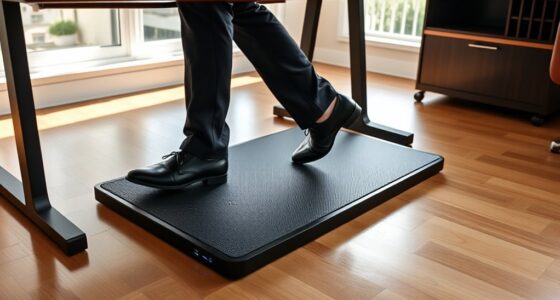If you’re looking for reliable portable power stations for camping in 2025, I recommend the Jackery Explorer 300, Anker SOLIX C300, a solar generator with a 280Wh battery, and the GRECELL T300. These options are lightweight, versatile, and packed with features like multiple charging ports, fast recharging, and solar compatibility. They’re perfect for keeping your devices powered during outdoor adventures. Keep exploring to discover more details that can help you choose the best one for your needs.
Key Takeaways
- Look for lightweight, compact power stations with at least 300Wh capacity for extended camping trips.
- Prioritize units with multiple charging options, including solar compatibility and fast recharging capabilities.
- Choose models with sufficient AC and USB ports to power diverse devices like laptops, lights, and small appliances.
- Opt for batteries with high cycle life, such as LiFePO4, to ensure durability over multiple outdoor adventures.
- Consider safety features like BMS and pure sine wave inverters for reliable, clean power in outdoor environments.
Jackery Portable Power Station Explorer 300
If you’re looking for a reliable and portable power source for camping, the Jackery Portable Power Station Explorer 300 is an excellent choice. It features a 293Wh lithium-ion battery, perfect for off-grid adventures, weighing just 7.1 pounds for easy transport. It can recharge up to 80% in 2 hours via wall outlet or 60W PD USB-C port, and it supports solar charging with Jackery’s SolarSaga 100 panel. With two Pure Sine Wave AC outlets, a USB-C port, and multiple outputs, it can power up to six devices simultaneously, including laptops, cameras, and drones. Safe, steady, and versatile, it’s ideal for outdoor use.
Best For: outdoor enthusiasts, campers, and travelers seeking a portable, reliable power source for off-grid activities and emergency backup.
Pros:
- Compact and lightweight design (7.1 pounds) for easy portability
- Fast recharging capability (80% in 2 hours via wall or USB-C)
- Multiple output options (AC, USB-C, USB-A, DC) support powering up to six devices simultaneously
Cons:
- Solar panel sold separately, requiring additional purchase for solar charging
- Limited 300W continuous power output may not support high-power appliances
- Lithium-ion battery may have a shorter lifespan compared to other battery chemistries over many charge cycles
Anker Portable Power Station SOLIX C300, 288Wh Lithium Battery
The Anker SOLIX C300 stands out as an ideal choice for campers who need reliable, portable power without sacrificing space or weight. With a 288Wh LiFePO4 battery, it delivers 300W continuous power and a 600W surge, enough for most small appliances and devices. Its compact, 15% smaller design makes it easy to carry, weighing just 4.1 kg. Featuring eight versatile outlets—including AC, USB-C, and USB-A ports—and fast recharge options, it’s perfect for off-grid adventures or emergencies. Built for durability, it offers impact resistance, quiet operation, and a 5-year warranty, ensuring dependable power wherever you go.
Best For: outdoor campers, travelers, and emergency preparedness users seeking reliable, portable power in a compact design.
Pros:
- Lightweight at only 4.1 kg, easy to carry during outdoor activities
- Fast recharge via USB-C ports, reaching 80% in 50 minutes
- Durable LiFePO4 battery rated for 3,000 cycles ensuring long-term reliability
Cons:
- Not compatible with Anker SOLIX PS30, PS200, PS400 solar panels
- Limited to 288Wh capacity, which may not power larger appliances for extended periods
- Slightly higher cost compared to basic portable power options
Portable Solar Generator with 60W Solar Panel and 280Wh Battery
A portable solar generator with a 60W solar panel and 280Wh battery is an excellent choice for outdoor enthusiasts who need reliable power on the go. Its foldable 60W monocrystalline panel boasts 20.5% efficiency, ensuring quick recharging via wall outlet, carport, or DC port. Compact and lightweight at just over 5 pounds, it fits easily into backpacks or vehicles. With dual 110V AC outlets, USB-A, and USB-C ports, it can power smartphones, laptops, cameras, and small appliances simultaneously. Built-in safety features like over-voltage and overheating protection, plus an SOS flashlight, make it a versatile, durable, and safe companion for camping, off-grid adventures, or emergencies.
Best For: outdoor enthusiasts, campers, and emergency prepper who need reliable, portable power for small devices and appliances on the go.
Pros:
- High-efficiency 60W foldable solar panel enables quick recharging in various environments.
- Lightweight and compact design (just over 5 pounds) for easy portability and storage.
- Multiple output ports (AC, USB-A, USB-C) support simultaneous charging of multiple devices.
Cons:
- Limited battery capacity of 280Wh may not power larger appliances for extended periods.
- Not waterproof; solar panel junction box requires protection from moisture.
- Max output of 300W restricts use to small appliances, limiting heavy-duty applications.
Portable Power Station 300W (GRECELL)
For campers needing a reliable power source that’s both portable and easy to use, the GRECELL T300 300W power station stands out with its compact design and versatile outlets. Weighing just 7.3 pounds, it packs a 230.88Wh lithium-ion battery and delivers 330W continuous power with a 600W surge. It features one AC outlet, multiple USB ports—including fast-charging USB-C PD 60W—and a car port. Recharging options include wall outlets, solar panels, and car chargers, thanks to its MPPT controller. Safety features like upgraded BMS and dual silent fans guarantee safe operation, making it perfect for camping, travel, or emergency backup.
Best For: campers, travelers, and emergency users seeking a compact, versatile, and reliable portable power source to run small devices and gadgets.
Pros:
- Lightweight and portable at only 7.3 pounds for easy transport.
- Multiple charging options including AC, solar, and car outlets with MPPT for efficient solar recharging.
- Safe operation with upgraded BMS, short-circuit, overload, and overcharge protections, plus quiet dual fans.
Cons:
- Limited continuous power output of 330W may not support larger appliances.
- Only one AC outlet, which might restrict simultaneous AC device use.
- Battery capacity of 230.88Wh may require frequent recharging for extended use.
Factors to Consider When Choosing Portable Power Stations for Camping

When selecting a portable power station for camping, I consider my power needs, how easy it is to carry, and the charging options it offers. I also look at device compatibility and how long the battery will last over time. Understanding these factors helps me choose the best unit for my outdoor adventures.
Power Capacity Needs
Choosing the right portable power station hinges on understanding your power capacity needs, so I always start by calculating the total wattage of all devices I plan to run simultaneously. This helps me determine the minimum capacity required. I look for a power station with a capacity that exceeds my total device wattage by at least 20-30% to handle startup surges and future additions. Battery capacity, measured in watt-hours (Wh), indicates how long I can power my devices; higher Wh ratings mean longer usage. I also check the maximum continuous power output to ensure it can support my highest-wattage device. For longer trips, I prefer models with 300Wh or more, providing reliable power over multiple days without worry. Matching capacity with my needs is essential for a smooth camping experience.
Portability and Size
Portability and size are essential factors because a power station that’s too bulky can hinder your outdoor experience. I recommend choosing a lightweight model under 10 pounds for easy carrying during hikes or camping trips. Compact dimensions, around 6 to 9 inches in length and width, help guarantee it fits comfortably into backpacks or vehicle compartments. Look for foldable or slim designs that maximize portability without sacrificing essential power outlets. Models with integrated handles or straps make transportation quick and comfortable, saving you effort. While size is important, don’t forget to balance it with capacity—your device should remain portable but still provide enough power for your needs. Ultimately, a well-designed, lightweight power station can seamlessly integrate into your outdoor adventures.
Charging Options Available
Having versatile charging options is essential because it guarantees your power station can keep all your devices powered in remote outdoor settings. I look for stations that support multiple methods, like AC outlets, solar panels, and carports, ensuring continuous power regardless of location. Fast charging capabilities are a game-changer, allowing me to reach 80% capacity in under an hour and save valuable camping time. Multiple ports, including USB-C, USB-A, and AC outlets, let me charge smartphones, laptops, and small appliances simultaneously. Solar recharging with integrated MPPT controllers boosts efficiency, reducing recharge times when using panels. The number and types of ports directly influence how many devices I can run at once, making versatile charging options a key factor in choosing the right power station for outdoor adventures.
Device Compatibility
When selecting a portable power station for camping, making sure it’s compatible with your devices is key. First, check that it has the right outlets, like AC, USB-C, or USB-A, to match your gadgets’ charging ports. It’s also important to verify the wattage and surge capacity to ensure it can handle devices like laptops or small appliances without overload. For sensitive electronics, look for pure sine wave outlets, which help prevent damage and ensure safe operation. Additionally, consider the charging options—solar, wall, or car—to keep the station ready during your trip. In conclusion, think about how many devices you need to charge at once, so your station can meet your outdoor power demands efficiently. Compatibility is essential for a smooth camping experience.
Battery Lifespan
Choosing a portable power station with a long battery lifespan is essential for reliable camping trips, as it determines how many times you can recharge your devices before needing a replacement. Typically, battery lifespan is measured in charge cycles, which can range from 500 to over 3,000, depending on the battery chemistry. Lithium Iron Phosphate (LiFePO4) batteries stand out with cycle lives exceeding 2,000 to 3,000, offering greater longevity than standard lithium-ion options. Several factors influence lifespan, including charging habits, operating temperature, and depth of discharge. Proper maintenance—avoiding over-discharging and excessive heat—can extend your battery’s effective life. When choosing a power station, look for manufacturers that specify expected charge cycles or years of reliable use, ensuring your outdoor adventures stay powered longer.
Safety Features
Safety features are crucial to take into account because they guarantee your devices and yourself stay protected during outdoor adventures. I always look for power stations with a robust Battery Management System (BMS) to prevent overcharging, over-discharging, and short circuits, ensuring safe operation. A pure sine wave inverter is essential to deliver stable power, safeguarding sensitive electronics like laptops and cameras from voltage fluctuations. Certifications such as UL, CE, or FCC reassure me that the device meets industry safety standards. I also check for overload, over-voltage, over-current, overheating, and short-circuit protections—these features prevent accidents and damage. Additionally, models with automatic shutoff and temperature regulation help prevent overheating during extended use, making sure the power station remains safe and reliable throughout my camping trip.
Price and Budget
Budget considerations play a significant role in selecting the right portable power station for camping. I recommend first setting your budget range and comparing options within it. It’s essential to find a balance between price and features, like battery capacity, output power, and recharging methods, to get the best value for your money. Keep in mind that higher-capacity units with advanced features usually cost more, so prioritize what matters most for your trips. Also, look for models that include warranties or good customer support, ensuring long-term reliability. Sometimes, investing a bit more in a reputable brand pays off, as it often means better durability and performance, ultimately saving you money and frustration in the long run.
Frequently Asked Questions
How Long Can These Power Stations Run High-Wattage Devices?
It depends on the power station’s capacity and the high-wattage device’s consumption. For example, a 2000Wh station can run a 100W device for about 20 hours, while a 500W device will drain it faster, roughly 5 hours. I always check the watt-hour rating and device wattage to estimate usage time. Planning ahead helps me guarantee my devices stay powered throughout my trip without surprises.
Are Portable Power Stations Safe for Indoor Camping Use?
Did you know that nearly 80% of portable power station users feel confident using them indoors? I believe they’re safe for indoor camping when used correctly. I always make sure to follow manufacturer guidelines, keep vents unobstructed, and avoid overloading. Proper ventilation and cautious use guarantee safety, making these devices a reliable and convenient power source for indoor adventures without worry.
Can These Devices Be Charged via Car or Solar Simultaneously?
Yes, many portable power stations allow you to charge via car and solar simultaneously. I’ve used mine this way to maximize efficiency, especially during longer trips. It’s convenient because you can keep the station topped off without relying solely on one power source. Just make sure your device supports multi-input charging, and always follow the manufacturer’s instructions for safe, simultaneous charging to avoid any issues.
What Is the Typical Lifespan of a Lithium-Based Power Station?
A lithium-based power station typically lasts around 2,000 to 5,000 charge cycles, which translates to about 5 to 10 years of regular use. I’ve found that proper care—avoiding full discharges, keeping it cool, and not overcharging—can extend its lifespan. Like all batteries, lithium ones degrade over time, but with good maintenance, they remain reliable for many camping adventures and outdoor activities.
How Lightweight Are These Power Stations for Backpacking Trips?
I find that many portable power stations designed for backpacking weigh between 3 to 10 pounds, making them quite manageable for most hikers. I prefer lightweight options because they won’t weigh down my pack or hinder my movement. Some models are compact and designed specifically for outdoor adventures, balancing power capacity with portability. Overall, I look for a station that’s powerful enough for my needs but light enough to carry comfortably.
Conclusion
When choosing a portable power station, think about your specific needs and how you’ll use it. For example, I once took my Jackery Explorer 300 on a weekend camping trip, and it kept my phone, lights, and small fridge running smoothly. Having reliable power made all the difference, turning a simple adventure into a comfortable escape. So, pick the station that fits your gear and you’ll enjoy worry-free camping whenever you hit the outdoors.















